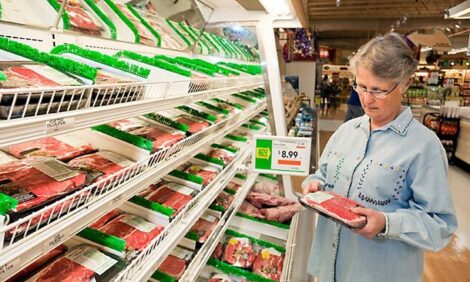



Cull sows: Have we learned the lessons of 2001?
UK - Once again we have lost our export market and cull sow values have fallen. So what are you doing about it? What you should not be considering, according to BPEX, is reducing your replacement rate. It can take years for a herd to recover its optimum parity profile and performance.
In 2003 Nadis vets reported significant production and health problems associated with retention of old sows in herds, as a result of a lack of disciplined culling.
To put the export ban in perspective we need to know what contribution cull sows make to overall revenue pig unit.
For a 100-sow breeder-feeder unit income might be valued at around £3,348 (2.2 per cent of total sales). Assuming 45 cull sows, each weighing 155 kg dwt, are sold based upon 48p/kg deadweight price. Finished pigs may yeild an income of £147,168 (for 73 kg dwt carcase at 96p/kg) and account for 97.8 per cent of sales.
If you do this calculation for your own unit you will see that, proportionately, cull sow revenue contribution is minimal.
What effect will the older, retained, sows have on the unit? Older parity animals can be more challenging to manage and be less productive due to:
Figure 1 shows we are losing over 40 percent of our young replacement sows before they have entered their most productive parities, with over 16 percent of replacement sows being culled as gilts. The main reasons for these losses are failure to breed and poor performance.
BPEX will be producing some new crib sheets on gilt management to help producers optimise both performance and longevity. Figure 2 shows a typical sow herd parity profile compared to an ideal parity profile.
Reducing culling rates from the first three parities allows more sows to be retained for their productive parities. It is no surprise that the top ten percent of units contributing to the BPEX Pig Yearbook 2007 data have the smallest proportion of their herd as gilts, when compared to the remaining herds, resulting in nearly 80 percent of their sows being between parities two and six.
The difference in replacement rate quoted here will be approximately ten percent. So in the short-term, whilst there is significantly reduced demand for cull sows, consider whether some of your intended culls may be suitable for re-serving, advises BPEX. Summer is the time of year when units often delay culling and save sows for one more parity anyway.
However, it is important that this is only the case where retaining extra animals in the breeding herd does not compromise stocking density and the environment of the productive sows.
Subsequently, in line with the scanning results for these animals, the breeding herd structure must be reviewed and culled out, taking into consideration the capacity of the farrowing accommodation.
Also, do not be tempted to offset the low cull sow value by drawing replacement gilts from the finishing herd.
This is especially important now with the modern genotypes, such as Hampshire and Pietrain, being widely use as terminal sires. The resultant gilt progeny will have reduced prolificacy, increased pre-weaning mortality and reduced farrowing rates.
Plan for the future. Remember the Japanese proverb – “When you are thirsty, it is too late to dig a well”.
To put the export ban in perspective we need to know what contribution cull sows make to overall revenue pig unit.
For a 100-sow breeder-feeder unit income might be valued at around £3,348 (2.2 per cent of total sales). Assuming 45 cull sows, each weighing 155 kg dwt, are sold based upon 48p/kg deadweight price. Finished pigs may yeild an income of £147,168 (for 73 kg dwt carcase at 96p/kg) and account for 97.8 per cent of sales.
If you do this calculation for your own unit you will see that, proportionately, cull sow revenue contribution is minimal.
What effect will the older, retained, sows have on the unit? Older parity animals can be more challenging to manage and be less productive due to:
- Body size – higher feeding costs for maintenance and potential problems of group integration and bullying.
- Increased incidence of stillbirths.
- More variability in the total number born.
- More variation within litter for piglet birthweights.
- Poor teat accessibility.
- Poor udder condition and function.
- Clumsiness and a higher incidence of locomotor problems.
Figure 1 shows we are losing over 40 percent of our young replacement sows before they have entered their most productive parities, with over 16 percent of replacement sows being culled as gilts. The main reasons for these losses are failure to breed and poor performance.
BPEX will be producing some new crib sheets on gilt management to help producers optimise both performance and longevity. Figure 2 shows a typical sow herd parity profile compared to an ideal parity profile.
Figure 1: Culls By Parity

Figure 2: Actual Versus Ideal Herd Profile.


Advice
BPEX will be producing some new crib sheets on gilt management to help producers optimise both performance and longevity.Reducing culling rates from the first three parities allows more sows to be retained for their productive parities. It is no surprise that the top ten percent of units contributing to the BPEX Pig Yearbook 2007 data have the smallest proportion of their herd as gilts, when compared to the remaining herds, resulting in nearly 80 percent of their sows being between parities two and six.
The difference in replacement rate quoted here will be approximately ten percent. So in the short-term, whilst there is significantly reduced demand for cull sows, consider whether some of your intended culls may be suitable for re-serving, advises BPEX. Summer is the time of year when units often delay culling and save sows for one more parity anyway.
However, it is important that this is only the case where retaining extra animals in the breeding herd does not compromise stocking density and the environment of the productive sows.
Subsequently, in line with the scanning results for these animals, the breeding herd structure must be reviewed and culled out, taking into consideration the capacity of the farrowing accommodation.
Also, do not be tempted to offset the low cull sow value by drawing replacement gilts from the finishing herd.
This is especially important now with the modern genotypes, such as Hampshire and Pietrain, being widely use as terminal sires. The resultant gilt progeny will have reduced prolificacy, increased pre-weaning mortality and reduced farrowing rates.
Plan for the future. Remember the Japanese proverb – “When you are thirsty, it is too late to dig a well”.








